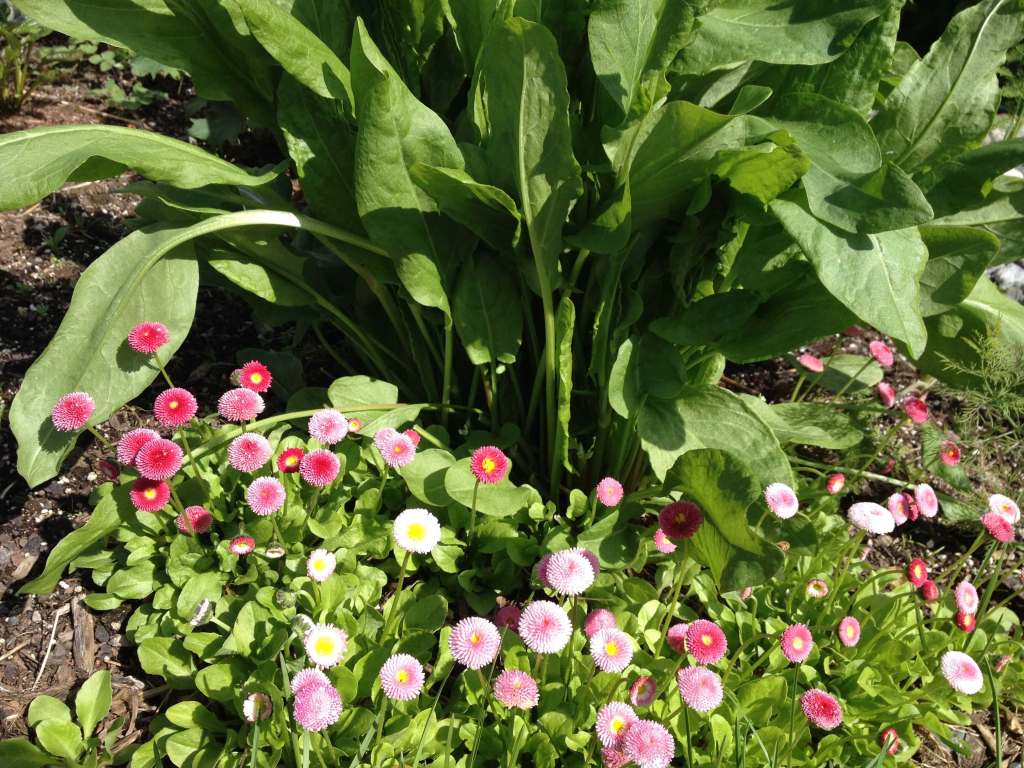When I was in college and needed to stay up all night to finish an assignment, I would head over to the student café and fill a bag with Sour Patch Kids™.
Those tart, chewy candies provided a shot of energy and comfort during my worst hours in libraries and computer labs. They were like a drug and I binged hard.
While I haven’t had a Sour Patch Kid™ in many years, I do reminisce about that candy quite often due to one plant in our vegetable garden: sorrel.

It isn’t sugary, but sorrel has an amazing, lemony tang when you bite into a fresh leaf. It only starts tasting like a vegetable to me after it is cooked.
Our sorrel came from seeds provided by Alaska gardener Saskia Esslinger at least a decade ago. The seeds were labeled French sorrel (Rumex scutatus) but I believe they are garden sorrel (Rumex acetosa) based on the more elongated shape of the leaf and the high acidity.
I’ve been growing the same patch of sorrel in my perennial garden bed ever since. In fact, now I have two patches. Every few years, I divide the patches and give away clumps to anyone who will take them.
Why grow sorrel?
The biggest plus for sorrel is that it’s a perennial vegetable in Alaska.
The sorrel we grow is native to Alaska and has several edible relatives. Many Alaskans enjoy the tart flavor of alpine or arctic sorrel (Oxyria digyna). The Rumex acetosa in my garden is one of the Rumex species known as sour dock, a traditional Alaska Native food. Another well-known edible is Arctic dock (Rumex arcticus).
In our Anchorage garden, the first shoots of garden sorrel emerge in April from the partially-frozen ground—about the same time as the rhubarb. (That is interesting to me, because both plants are high in oxalic acid, which is responsible for their sour taste.)

Garden sorrel requires very little attention. In fact, the only attention I give it is what I give its neighbor plants—water and occasional compost.
Another great thing about sorrel is that it isn’t bothered much by pests. Yes, I occasionally find slugs, but they don’t seem to do much damage. They just take a nibble here and there and then move on. Perhaps this is due to the oxalic acid, which plants use to repel insects and animals.
Our sorrel plants go to seed in early summer. At that point I hack them down and let them grow back for another crop.
How do we use it?
Most of the fresh leaves I gather become pesto and sorrel sauce, and the flowering stalks go to the community compost station.
The leaves are OK in salad but if eating raw, my preference is pesto. I freeze the pesto and we eat it in pasta all winter. The cooked version of sorrel sauce is OK frozen, too, and is nice on potatoes.
An important fact about sorrel is that when cooked, it will quickly turn from bright to drab green and melt down to a little blob in the pan.
Each summer, I experiment with a fancy or unusual dinner using sorrel—French sorrel soup or salmon and sorrel, usually. We’ve also tried gongura (sorrel) dal, rhubarb sorrel crisp and vegetarian borscht made with sorrel.
Unfortunately, except for the gongura dal, I’ve been disappointed so far in my search for a soup or main course with sorrel that pleases my taste buds.
One of these days, I’ll try to make candied sorrel leaves, to see if they taste at all like a Sour Patch Kid™. I’d also like to try making sorrel pasta or sorrel gnocchi.
Until then I will churn out sorrel pesto and enjoy sugar-free snacks from the sour patch.

Hi Liz! Glad to see more info on sorrel. My little patch comes up reliably every year as well, and I’m always looking for ways to use it. Haven’t tried the pesto idea but will this year. Here’s a nice salad dressing recipe that I like a lot: https://www.tastingtable.com/recipe/little_gem_salad_recipe_tastingtable.pdf.
Thank you for the recipe Janice! I talked to someone in Kotzebue yesterday who likes to eat the leaves with blueberries and a little bit of sugar. I think she cooks it very briefly. She generally always ads sugar to sorrel even if it is a salad.
Just found this as I just tried sorrel for the first time and it reminded me of sour patch kids! I decided to ask the internet if it is or can be used in sour candies. Would be curious to hear if you have tried making candied sorrel yet! Live long and prosper friend.